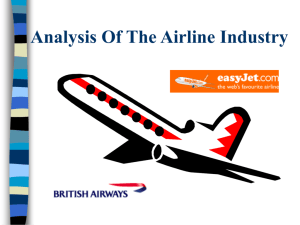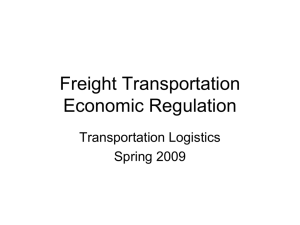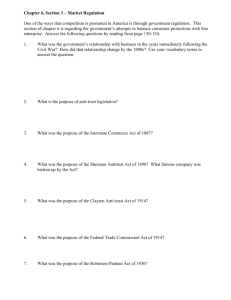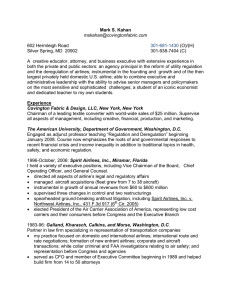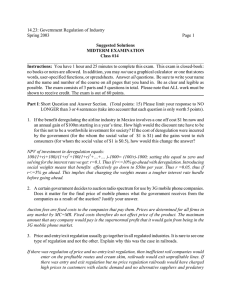Document 13572874
advertisement
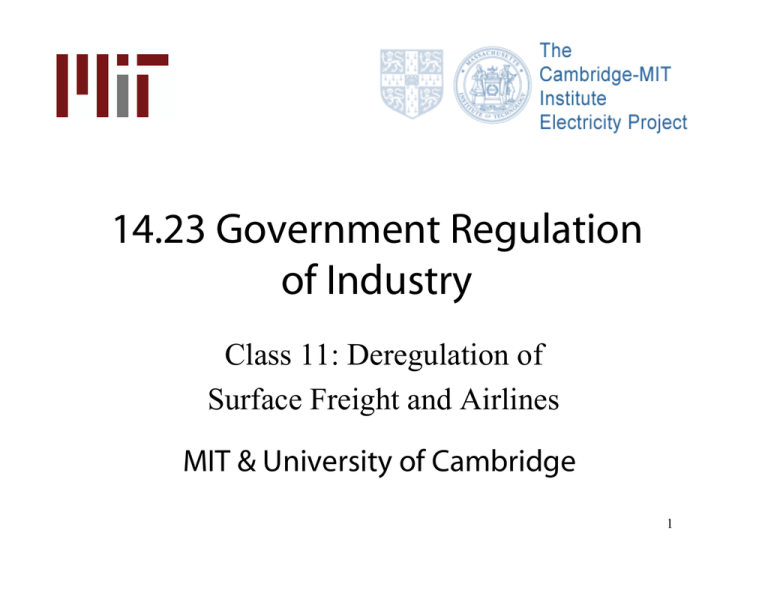
14.23 Government Regulation of Industry Class 11: Deregulation of Surface Freight and Airlines MIT & University of Cambridge 1 Outline • The theory of why price and entry regulation are inefficient for naturally competitive industries. • Rail, trucking and airlines were all heavily regulated until the 1970s. • They have since between substantially deregulated. • We examine each in turn and ask the question: how was regulation effecting them? 2 Price and Entry Regulation • • • • The heart of regulation is the control of entry and price. Price regulation can be above or below cost. Entry and exit regulation have similar effects. Entry/Exit regulation and price regulation are necessary complements. What happens: • (1) when price regulation is above cost and there is no entry regulation? • (2) when price regulation is below cost and there is no entry regulation? • (3) when there is limitation on entry and no price 3 regulation? Regulation of Competitive Market $ D Competitive market can support 20 firms. However if regulated price and entry, price rises and demand falls so costs rise. However if prices are regulated free entry would make situation worse. What are welfare losses? AC(Q) PR P* 0 Q2/21 Q1/20 Q2/20 Q2 Q1 Q 4 Second Best Effects of Regulation • Given regulation of first market is regulation of a second related market a bad thing? • Imagine you have one regulated firm supplying market 1 and a second firm could supply the market but at higher cost but slightly lower quality. • If you regulate the PR>MC2>MC1. Firm 2 will enter but this is not in society’s interests. • The answer is to force both firms to charge a price no lower than PR. • This is beneficial if the benefits of lower costs exceed the consumer surplus losses. • What would happen in a competitive market? $ PR D(P) MC2 MC1 0 Q0 Q Qf 5 Imperfectly Competitive Model • In the presence of substantial fixed costs and significant MES relative to market size it is not clear that entry increases social welfare. • This is because entry occurs up to the point where it is just unprofitable for the entering firm but this is not the same as the point where social welfare is maximised. • Society incurs the fixed cost of entry for sure while the entering firm benefits from shifting profits from the other firms to itself. • This phenomenon can lead to excessive competition in a simple Cournot model (relative to the social optimum). • However the social costs of this can be low relative to a ban6 on entry (see book example). Indirect Effects and Innovation • Excessive non-price competition (e.g. airlines: food, safety, legroom) • Production inefficiencies: high wages, leading to K/L ratio changes, inefficient firms continue to operate. • Cross-subsidisation: where enforced prevents exit and is welfare reducing. – May also lead to reduced investment, productivity and quality may fall. • May be more investment under regulation but less incentive to innovate. There does seem to be a slowdown in productivity into 70s in regulated industries. 7 Approaches to measuring effects of regulation • 1. Inter-temporal approach. Look at given industry over time with and without regulation and observe differences. • 2. Inter-market comparison. Where 1. is not available can compare regulated and unregulated markets for similar products or different jurisdictions. • 3. Counter-factual approach. Try to use as a benchmark what market would have looked like in the absence of regulation. 8 Regulation of Surface Freight • Rail and trucking looked at together because they are close substitutes for freight. • 1870s: Railroads seek regulation to protect them from price wars. • 1887: ICC established to regulate railroads, rates to be ‘just and reasonable’ and non-discriminatory. • 1906: Maximum rates imposed. • 1920: Minimum rates and control of entry and exit imposed. • 1920- Truck competition begins to undermine profitability of rail. • 1935: Motor Carrier Act: brings trucks under ICC control (prices and entry and exit). 9 Deregulation of Surface Freight • • • • • • • • 1940s: Railroads want less regulation now trucks are regulated. 1950s: Interstate highways with unregulated/own trucking hit rail. 1958: Some lower rail rates and some passenger exit allowed. 1976: Railroad Revitalization and Regulatory Reform Act (4R Act) allows zone of reasonable rates and freedom to exit unprofitable routes. 1980: Staggers Rail Act. Considerable rate setting freedom and freedom of entry and exit. 1980: Motor Carrier Act. Deregulates ICC further. 1980s mostly deregulated. 10 1995: ICC finally wound up. Why was there regulation? • Price instability with railroads: destructive competition, and difficult to enforce collusion. • Financial markets thought regulation good for profitability (Prager finds stock price rises with passage of ICC - why is this a good measure?). • No natural monopoly in trucking. • Rationale for regulation simply its complementarity with rail. • In practice the regulation of the two was different. 11 Rail Regulation • ICC set minimum and maximum rates. • Rates based on value of service and equalizing discrimination. • ‘Value of service’ pricing meant higher prices for goods of higher value (not necessarily any more costly to transport). • ‘Equalizing discrimination’ prevented discrimination between different shippers and different sizes of shipments even when the costs 12 were different. This implies cross subsidy. Trucking Regulation • ICC allowed industry ‘bureaus’ to set prices. • Rates could not vary across routes of similar distance (even where densities varied). • Rates could vary by shipping size/characteristics of shipper. • Thus trucking companies got prices they wanted whereas rail industry did not. • In rail regulation prevented exiting of unprofitable routes. • However in trucking entry restriction kept prices up. 13 Effects of regulation • The inter-temporal approach focuses on the effect on prices before and after regulation. • Difficult to analyse given changing input costs and nature of traffic. • However it appears that rail rates fell on most routes after deregulation, though on some they rose. • For trucking there was a fall in prices in 14 general after deregulation. Effects of regulation • Railroads faced exit restrictions. After the Staggers Act railroads abandoned unprofitable markets. Conrail abandoned 2600 miles (15% of total track and only 1% of revenue). • Trucks faced entry restrictions. Number of certified motor carriers doubled between 1978 and 1985. Bankruptcies rose. • Unit costs have fallen and are more highly concentrated at the low end of costs. • Union premium over non-union wages fell from 50% to 27% (below the national average). • Investment in track went up as profits improved. • Regulated industry productivity was low compared to 15 elsewhere but does appear to have accelerated. Effect of Deregulation on Profits • Deregulation sharply increased profitability of rail. Rate of return doubled in four years. • Why? – – – – Freedom to exit. Rate flexibility allowed better demand management. Lower labour costs. Increased investment leading to increased efficiency and lower costs. – Long term contracting with shippers leading to optimal investment planning. 16 Regulation of Airlines • 1920s: competitive bidding for US mail looking like destructive competition. • Airlines realised that although contracts were allocated on a least cost basis, after award there was no regulation of price, hence the competition effect. • 1938: Civil Aeronautics Act falls under Federal regulation of Civil Aeronautics Board (CAB). • 1958: Federal Aviation Administration (FAA) takes over regulation of safety from CAB. • CAB regulates max and min rates and number of competitors. • Number of airlines fixed at 1938 level and falls with mergers.17 Deregulation of Airlines • 1975: Head of CAB eases entry restrictions. • By 1977: Further entry restriction reductions and control of fares relaxed. • 1978: Airline Deregulation Act. • By 1979 free entry was allowed. • By 1980 unlimited downward price flexibility. • By 1983 all controls ended. • Initially a lot of entry, now consolidation around hub and spoke system. 18 Effects of Deregulation • Prices: – These fall especially on long distance as cross subsidies unwind. • Quality: – Regulation led to high quality-high price product. Deregulation has led to? • Hub and Spoke System: – Unexpected innovation. Saves money for airline by increasing utilisation on flights. Why? However also increases value to passengers due to more frequent departures. 19 America West Airlines Routes 2003 Map: Graphic Removed 20 Source: http://www.americawest.com/aboutawa/companyprofile/aa_routemap.htm Consumer Welfare Effects of Deregulation of Airlines Category Fares Travel Restrictions Frequency Load Factor Number of Connections Mix of Connections Travel Time Total Annual Gain $bn (1993) 12.4 -1.1 10.3 -0.6 -0.7 0.9 -2.8 18.4 Source: Morrison and Winston (1995). 21 Conclusions • Regulation of potentially competitive industries usually leads to higher prices and costs. • Regulation tends to spread to related sectors. • Deregulation of rail and trucking shows how previous regulation was increasing costs and distorting prices. • Deregulation of airlines shows a substantial benefit from unanticipated innovations under competition. 22 Next • Revision for Midterm – Look at Problem Sets and Handouts. – Look at Mock Exam (to be posted). – E-mail me your questions. • Reminder ONLY simple calculator will be allowed in Midterm. 23
